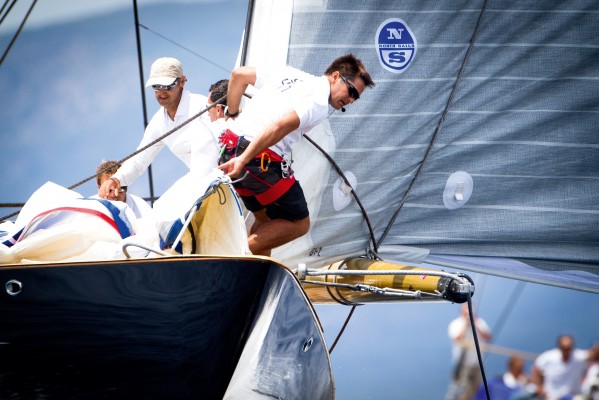Elaine Bunting reports from on board Rainbow at the Superyacht Cup Palma regatta, as she experiences the thrill of sailing on a J Class yacht
Each of the Js takes 32 or more crew for racing and on average 12-15 of them are top pros brought in for each campaign. No one wants to be explicit about money; I heard wages typically run at between €500 and €2,000 a day, plus expenses.
It was this incursion of larger numbers of skilled, highly-paid professionals that led to a major rift in the J Class in 2010. Jim Clark, owner of Hanuman, withdrew from Antigua Classics in protest and published an open letter stating:
‘. . . I was adamant that I would not spend a lot of money just to win a race. Then I heard for the first time that Ranger had 17 paid professionals and I chose not to compete against a professional team.
‘The world of sailboat racing can be quite fun, but spending obscene amounts of money to win a race, in the opinion of most reasonable people, is not a very worthy thing to do. It contributes to an elitist image of sailing, which I have never wanted to be a part of.’
His entreaties failed to persuade other owners to scale back and it is now the norm, even on Hanuman, to race with a cadre of elite sailors. It would appear to be the price of winning and, many would argue, to safer racing.
Kenny Read speaks freely of the difficulties of sailing Hanuman and the jangle of fear that periodically mixes with competition. “These boats are fully loaded and on the edge,” he explains.
“The pro sailors are there as much to stop people being killed as to win a race. The loads are 20 tonnes on this, 25 tonnes on this. It was unfathomable two or three years ago that we would be sailing these boats to this level. It’s nothing short of terrifying at times.”
Toby Brand, skipper of Lionheart, agrees, saying:
“The runner loads are scary. So are the headsail sheet loads. But the most scary is the pole work. We’ve got an 18m pole and it’s very hard to handle. The most difficult and skilled jobs are co-ordination in the pit. On gybe sets at the top mark, we’ve got ten winches running. Everyone has to do the right thing, at the right time, at the right speed. We couldn’t do that without top professionals, that’s absolutely clear.”
The rudders of the Js, which have to remain in accordance with the original lines plan, are all highly loaded, with rather small steering arms. Long overhangs at bow and stern, and the leech of the mainsail set behind the rudder mean that sail trim has a huge effect; a J can stubbornly refuse to answer the helm if trimmers aren’t working in co-ordination.
“They are very physical boats to sail and everything has to be decided two minutes prior,” says Read. “I’ve never been on a boat where you have to think so far ahead. It takes a lot of time to start and stop 185 tonnes. You can’t turn easily, don’t accelerate; mistakes get hugely magnified. You are committed from many boatlengths away. You turn the wheel and the boat doesn’t start responding for eight or ten seconds.”




